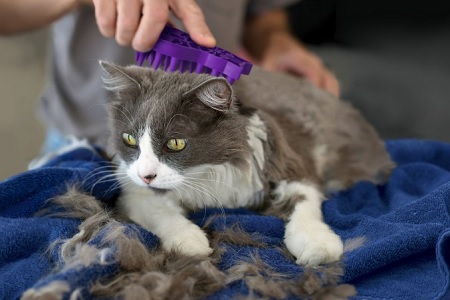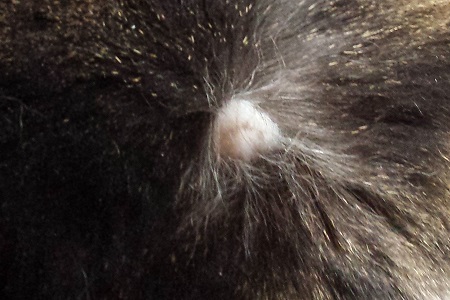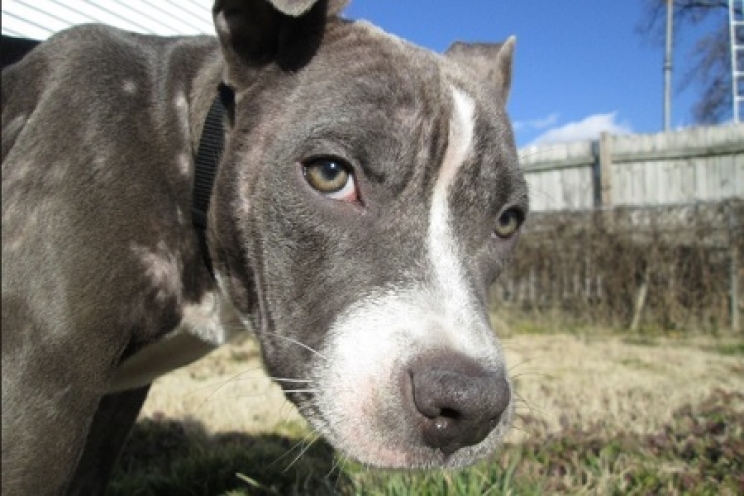Every pet owner knows what it is like when you animal starts to shed. Sofas and clothes are covered in hair, piles of fur flying on the floor, adhesive rolls wasted on cleaning up the fabrics. When it comes to hair loss in animals, we must understand if it is a simple seasonal "moult" or a more complex dermatological problem.
The seasonal "shedding"
Hair loss in animals can be considered normal especially if it occurs during the so-called "moult. In other words, when the animal replaces its current hair with the most appropriate one for the upcoming season.

In particular, during the spring or summer period, the animals "strip" of the thick winter undercoat, in order to tolerate the hot temperatures. Conversely, in the fall they prepare to keep warm with an additional layer of soft fur.
In most cases, the animals shed their fur mainly due to the spring moult. In this circumstance, the loss is constant and uniform for the whole body, so it is rarely possible to observe areas with bald patches or completely absent hair.
The only aspect that can be considered is a change in the texture of the coat, based on the breed and type of hair of the animal. The winter coat is warm, voluminous and fluffy. The summer one, on the other hand, is less hot and not very voluminous.
Furthermore, the shedding process can be distinguished by the fact that it starts from the posterior areas of the body, and then passes to the anterior ones.
Other causes of hair loss
Dogs and cats can shed their hair even in the presence of certain conditions and disorders. These can manifest themselves differently depending on the type of problem, so by observing the animal's coat you can get more information.
The main skin and hair problems we might come across are:
- Fungal infections: the fungi Microsporum and Trichophyton are responsible for skin mycosis or dermatophytosis, or infections caused by fungi. The most frequent in our animals are ringworms, which manifests itself with the appearance of one or more hairless areas, usually rounded. The presence of the fungus can inflame the skin, with flaky dandruff and crusts, only in the area where the hair is missing. The animal might feel itchy. The parts of the body most affected by dermatophytosis are mainly the muzzle, neck, back and buttocks. Skin mycoses is easily transmitted from animals to humans and vice versa;
- Parasites: the animal may lose its hair due to the presence of some parasites. The most frequent are mainly fleas and ticks, which are able to trigger severe itching and causes the dog or cat to scratch himself brutally, creating wounds and tearing the hair in the affected area. Another infection caused by parasites is mange, of which there are various forms, such as sarcoptic mange or scabies, demodectic mange or demodicosis, and notoedric mange. All these infections are caused by different mites;
- Bacterial infections: pyoderma is the most common bacterial skin infection in our animals. The presence of the bacteria causes the appearance of very red, blister-like patches with a rounded shape and very itchy. If left untreated, the blisters can fill with pus and blood, often resulting in more serious problems, such as "abscesses", which are cavities that are carved into the skin;
- Food intolerances and allergies: some animals may not be able to tolerate some ingredients present in specific foods. Each time they ingest them, the body responds with inflammation, which can then create major problems around the whole body. These include mainly skin irritations and infections, which mainly manifest themselves with hair loss, dandruff and itching;
- Contact atopic allergies: these allergies occur when the animal's immune system reacts disproportionately to some harmless factors. In the case of contact allergies, these factors are some substances that come into contact with the animal's skin and create itching, redness, swelling and hair loss. Atopic allergies or atopies, on the other hand, are a separate thing, because they occur without a precise triggering cause, but based on a sudden and autonomous reaction of the immune system;
- Insect bites: bee and mosquito stings can cause severe itching, so the animal will tend to scratch and lick its fur violently, causing it to fall off;
- Unbalanced diet: the food for our animals is specially designed to ensure the right supply of all the nutrients necessary for the health of their body. For this reason, by providing them with an unbalanced or unsuitable diet according to their species, we could deny them essential substances. In particular, as regards to hair loss, this occurs above all if the animal does not take the right amount of amino acids, that is the building blocks of proteins, and also of Omega-3 and Omega-6 fatty acids which are the substances that ensure the beauty and integrity of the skin and coat. The hair appears so dull, dry and will begin to fall out in excessive quantities;

-
Stress: when we are particularly stressed, for example due to overwork or before an exam, the first sign is hair loss. This can also occur in animals for different causes and is generalized throughout the whole body;
- Anxiety: animals that are too agitated often tend to lick or bite parts of their body, in particular the legs and belly areas and eventually tear their hair;
-
Inappropriate grooming: animals wash themselves through grooming. However, it may happen that, due to certain disorders and situations, they begin to intensify or reduce the cleaning operations. In the first case, the prolonged action of rubbing the tongue on the hair can create irritation and fall of the hair, whilst in the second case it can increase the chances of accumulation of impurities and bacteria and fungi;
-
Environmental conditions: if we were turn on the heating in winter or the dehumidifier in summer too often, our animals may be affected. An excessively dry environment, in fact, changes the structure of the skin, which dehydrates together with the skin;
-
Scars: Following accidental wounds, bites, surgery or injections, the skin can react by forming a scar, and the hair in this area will stop growing;
-
Childbirth: immediately after childbirth, all the hormones that had remained in place during pregnancy, including testosterone, are reactivated in the female. This hormone (mainly produced in males) which is also produced in females in small quantities, stimulate hair loss.
Symptoms
Hair loss can manifest itself as an isolated condition, especially in the period of "moulting", but it can also be accompanied by other symptoms, such as:
- Alopecia: is the presence of hairless areas in a limited area of the animal's body;
- Itching: the animal may feel itchy due to irritation, infections, food allergies or insect bites. He will react by licking, biting and scratching the area that itches the most;
- Dandruff: appears when small flakes of dead skin detach from the skin, so you can see the presence of small white fragments between the animal's hair;
- Scabs: the skin thickens and a thin rough layer forms, usually pink or red;
- Greasy hair: when we stroke the back of our pet, a feeling of dirt or grease may remain on our hands. It is the main symptom of seborrheic dermatitis, an inflammation of the skin, but it can also accompany other skin conditions;
- Dull coat: the coat appears dull, dry and bristle.
What should I do?
If our dog or cat sheds, the veterinarian must choose the therapy. In fact, only after having ascertained the cause of the problem can we proceed with the most suitable treatment.
In case of infections, it will be necessary to administer antifungal or antibiotic substances to the animal, respectively for fungi or bacteria. Your vet may prescribe oral medicines or lotions to apply directly to the lesions.
The type of food should also be adjusted if the animal loses too much hair. The meals must be specific, high quality and easily digestible. By providing home nutrition or food that is not suitable for the animal species, food allergies or deficiencies in some nutrients may arise. Your vet will be able to recommend an appropriate product based on the problem.
In the event of widespread hair loss throughout the body, especially during the "moult" period, it is very important to intensify the grooming of the animal, brushing it every day. On the market, you can find various brushes and combs for all hair types, so ask your trusted dealer for advice.










